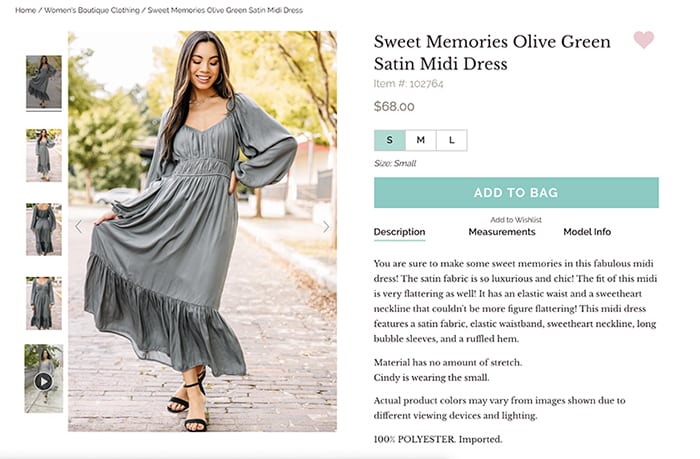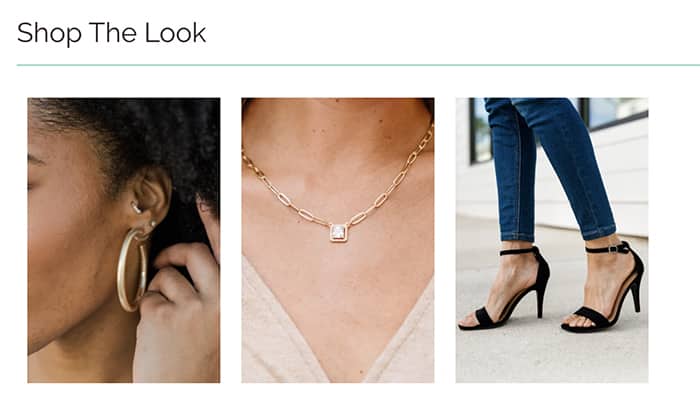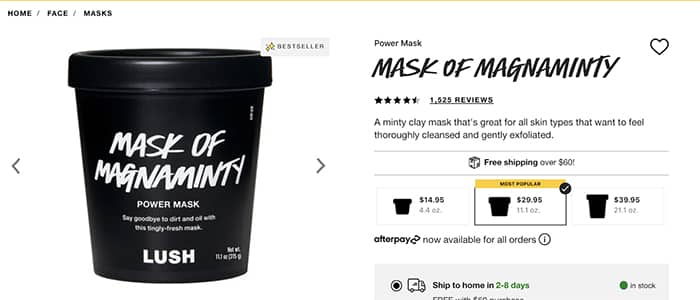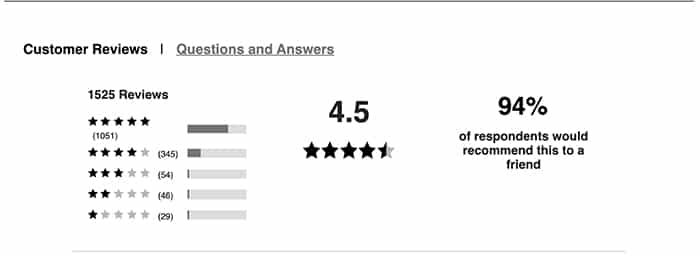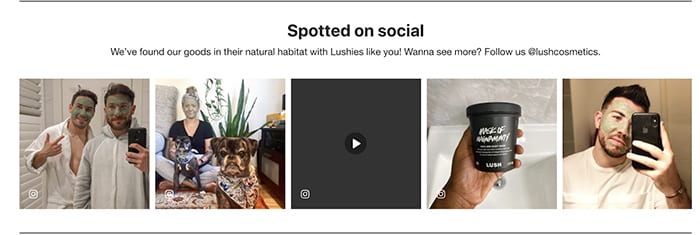Cross-selling is motivating customers to buy additional products related to what they are already buying. The right cross-selling strategy can significantly increase sales and build customer loyalty. When cross-selling, ensure that your offer is relevant and provides more value to the customer.
We outline 15 cross-selling tips and techniques in this article for ecommerce shops and brick-and-mortar retailers.
Cross-selling Techniques for Ecommerce Stores
In ecommerce, cross-selling techniques are more often used on product pages, during the checkout process, and in customer lifecycle campaigns—cart recovery emails, order confirmation emails, and even regular customer newsletters. Here are some cross-selling tips you can apply to your online store:
1. Offer Related Items for Your Big-ticket Products
Find your flagship products or big-ticket items and pair them with directly related products. These include items that your customers need to enhance the features they are looking for in your main product. Once you have your list, you can decide how to place them.
Best Practice Tips:
When planning for cross-product placements:
- Pitch low-cost products and smaller accessories that cost 10% of the main product at checkout page.
- High-ticket items and larger accessories that cost 15%–50% of the main item will sell better if displayed on the product page.
- Tap into a shopper’s impulse buying behavior. For example, offer related products that are easily missed: earphones for mobile phones, belts for pants, etc.
- Use phrases such as “Customers also bought,” “Shop the look,” “You may also like,” or “Popular related products” to encourage shoppers to buy.
Cross-sell Tip in Action
In Product Pages
2. Limit the Number of Product Recommendations
Limiting the total number of options you try to cross-sell is a sound practice, especially for small businesses. Business owners sometimes forget to exercise restraint and display a long list of additional products customers can purchase. When this happens, buyers can become so overwhelmed with side offers that they abandon their shopping cart altogether.
Best Practice Tips:
- The ideal number of cross-selling offers on a page is three. This gives just enough window in the checkout stage to increase the customer’s attention span and your conversion ratio.
- Hand-pick your offers so they include products that really fit the customer without taking focus away from the products in their cart.
Cross-sell Tip in Action
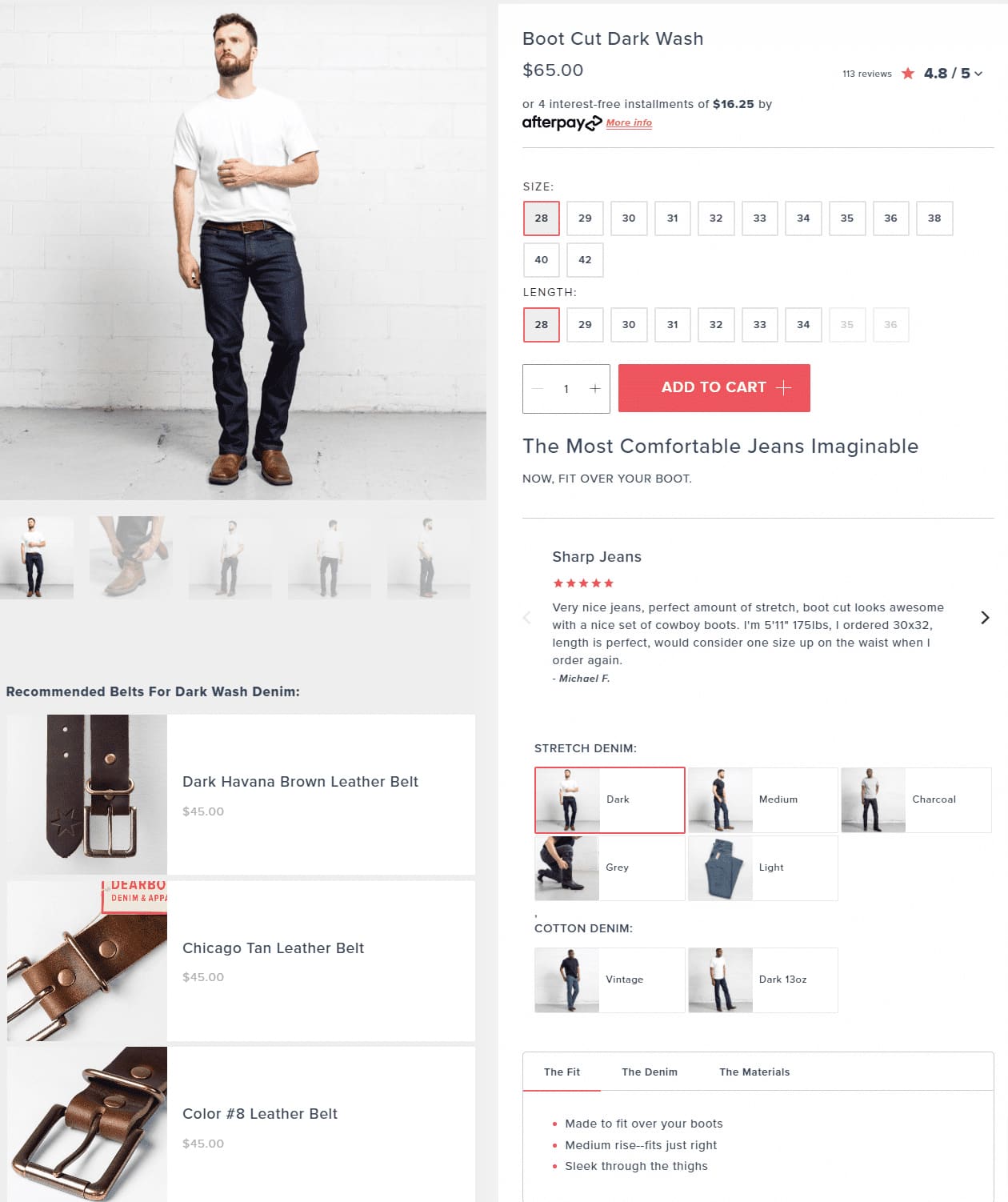
An example of a cross-selling technique of DearBorn Denim that just recommends up to three products, on top of the jeans a customer is originally looking to buy.
3. Create Limited-time Offers
There’s nothing like a little sense of urgency to get customers to take action. This is something you can also use to make the most out of cross-selling. You can present limited-time deals with popular items along with a customer’s original purchase to really get them thinking. Be sure to stress the fact that the deal does expire eventually.
Best Practice Tips:
Some great ideas that can increase the sense of urgency are:
- Flash sales/today’s deals
- “Special Day” discounts
- “Last Chance” promos for customers who previously showed interest
- Clearance sales
- “While stocks last” special offers
You may try giving customers up to six hours to decide if they want the deal or not. Just don’t make the timeline too short (it may stress them out) or too long (the offer may lose the sense of urgency).
Cross-sell Tip in Action
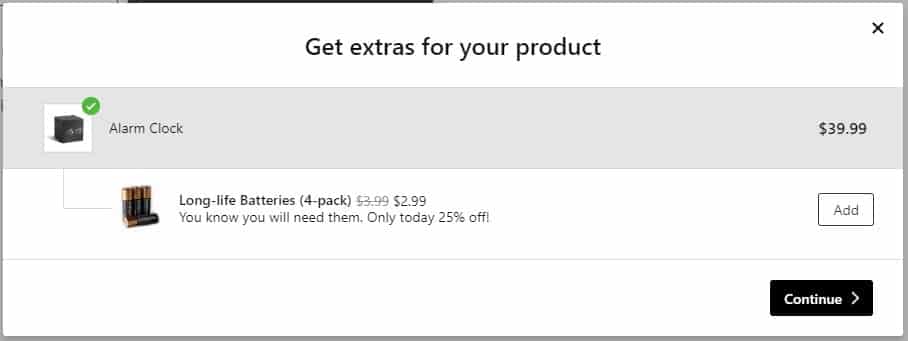
An example of a limited-time offer using a Shopify checkout page.
4. Highlight the Total Price at Checkout
Most shoppers have a budget in mind even before they go to an online store. The basis of their buying decision is when they are assured their choice is the best balance between quality and budget. Naturally, it will be difficult to convince buyers to purchase additional products that will push them way beyond what they expect to pay. To get buyers to consider adding the products you recommend, you’ll need to base your recommendations on the total price at the checkout stage.
Best Practice Tips:
- Try to keep your suggestions below 60% of what’s already in the cart. When a shopper is anchored to a price range, you need to show small products so they won’t be discouraged from completing the purchase.
Cross-sell Tip in Action
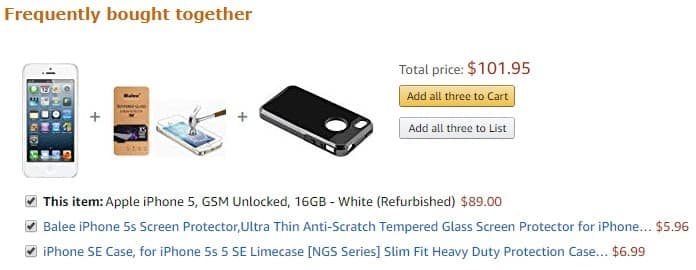
Amazon makes it easy for a customer to see the value of adding products by displaying the total price if all items were purchased together.
Ecommerce platforms such as BigCommerce and Shopify have built-in apps and third-party integrations for product recommendations, customer reviews, and cross-selling. Learn more in our guide to the best ecommerce platforms.
5. Offer Bundles
Reduce decision-overwhelm for shoppers by offering bundles. Studies show that helping shoppers decide by reducing complexity and narrowing choices can boost revenues by 5% to 40%. Bundles are the most popular cross-selling strategy according to Hubspot research—63% of sales teams employ this technique.
Best Practice Tips:
- Mix low-selling items with fast-moving ones.
- Offer two or more products at a single price.
- Offer a set of high-priced and low-priced products together at a single price.
- Offer multiple varieties of products together at a single price.
- Let customers choose what they want in a bundle—this is an incredibly powerful cross-selling tactic. Allow them to make their own bundles and see how eager they are to buy from you again!
Cross-sell Tip in Action
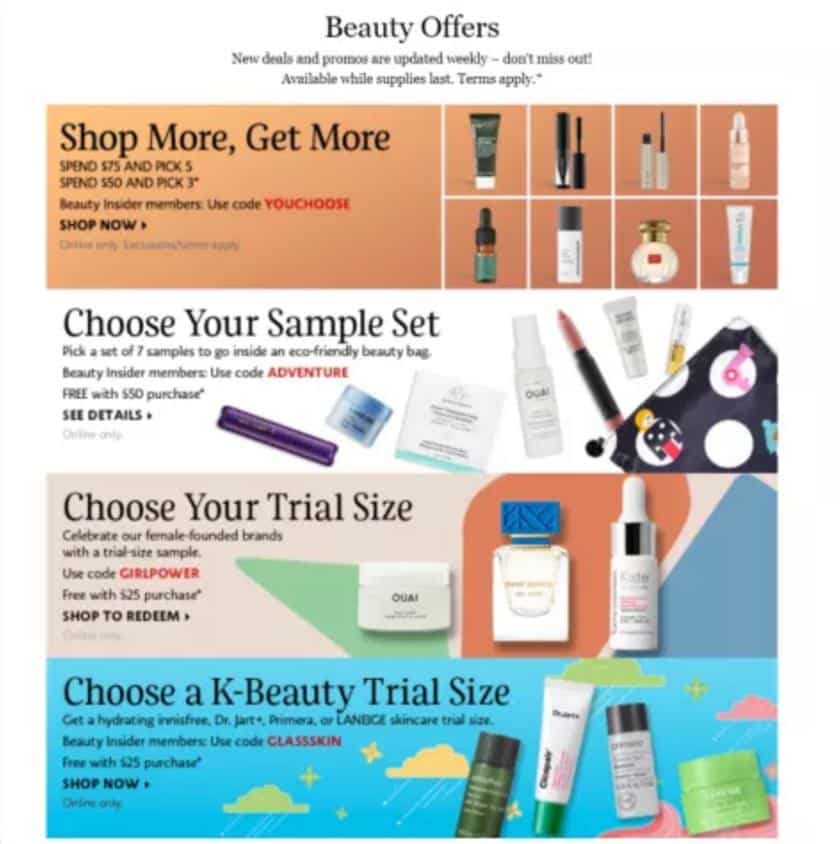
Makeup retailer Sephora uses bundling so effectively, offering prepackaged and per-customer bundles, giving its customers a little bit of control over what items they add to the deal.
6. Use Social Proof to Your Advantage
A study by Barilliance finds that the most engaging recommendation type is “what customers ultimately buy.” This further supports how using social proof can be to your store’s advantage. Social proof refers to using online feedback from satisfied customers to help your business. The main objective is to build trust with online buyers considering your products. To help with cross-selling, you should reference positive online feedback for your products to encourage sales.
Best Practice Tips:
- Show how many people have already bought the product or are currently looking.
- Showcase customer testimonials, product reviews, and ratings.
- Display visual user-generated content (UGC).
- Display expert reviews or product awards.
Social proof provides you with the easiest persuasion strategy to deliver a compelling offer in a format that consumers trust the most. The customer reviews and expert feedback show your potential buyers how popular your products are. It also allows you to demonstrate how these products can make their lives easier and enhance the performance of the main product they are purchasing.
Cross-sell Tip in Action
7. Personalize Your Offers
Your ecommerce website might not be able to carry content like a blog can, but it doesn’t mean your message can’t be as strong. Content personalization will go a long way in presenting your products and gives you a much better chance at making a sale. The key is to find the right time and place for employing personalized content.
Best Practice Tips:
Here are some personalization strategies you can try:
- Use your customer’s name.
- Use words like you, your, and yours.
- Personalize a widget like a bubble that appears in different pages of your website.
- Personalize a web part like banners on your website.
Using your customer’s name will easily attract their attention, and using “you,” “your,” and “yours” help make the shopper visualize ownership of the products you’re cross-selling. Personalizing a widget or web part is useful when you want to remind customers of the product that’s relevant to items that are already in their shopping carts.
Cross-sell Tip in Action
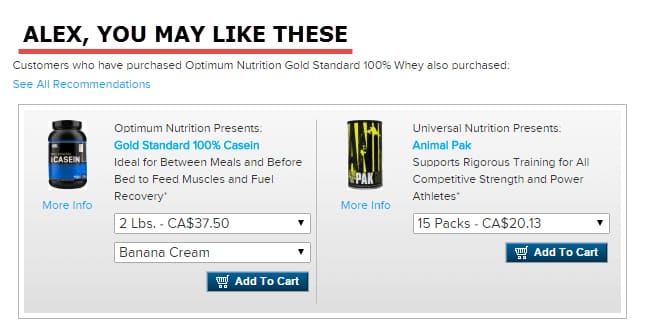
An example of a personalized cross-sell technique based on product recommendations. Instead of just saying “You make like these,” inserting the customer’s name adds a personal touch.
8. Have Order Thresholds
Displaying order thresholds—getting an incentive by doing a minimum/maximum spend—may not technically classify as a cross-sell as you are not actively recommending supplementary products to your customers. You are, however, incentivizing them to spend more by notifying them of an order discount threshold.
Best Practice Tips:
- Display the offer prominently in your online store, across product and checkout pages.
- Make order thresholds interactive. Display the amount customers need to spend to unlock the special discount or offer when they add items to their cards.
- Utilize pop-ups to notify customers of the incentive.
- Free shipping is one of the leading drivers of online sales—using this as an incentive can help customers spend more in your shop. Learn how to offer free shipping on your products.
Cross-sell Tip in Action

We like how all-natural beauty brand Bathorium displays its incentive—a free shipping option for a minimum spend—prominently below the Add to Bag button.
9. Educate & Provide Value First
A key principle in cross-selling is to help customers make better buying decisions—suggesting products that make sense to them and are relevant to their needs. This can be a challenge for your online store, as you can’t get immediate feedback from your customers and know what they need. However, you can use customer data from your CRM or order history to offer informed recommendations that are likely to meet their needs.
Best Practice Tips:
- Make your customer’s convenience a top priority when designing your cross-sell offer. This will make it more organic and possibly more effective.
- Don’t suggest additional items before a customer picks a product.
- Never bombard customers with too many cross-sell products.
- Make it easy for them to add to their carts when you are demonstrating products.
Cross-sell Tip in Action
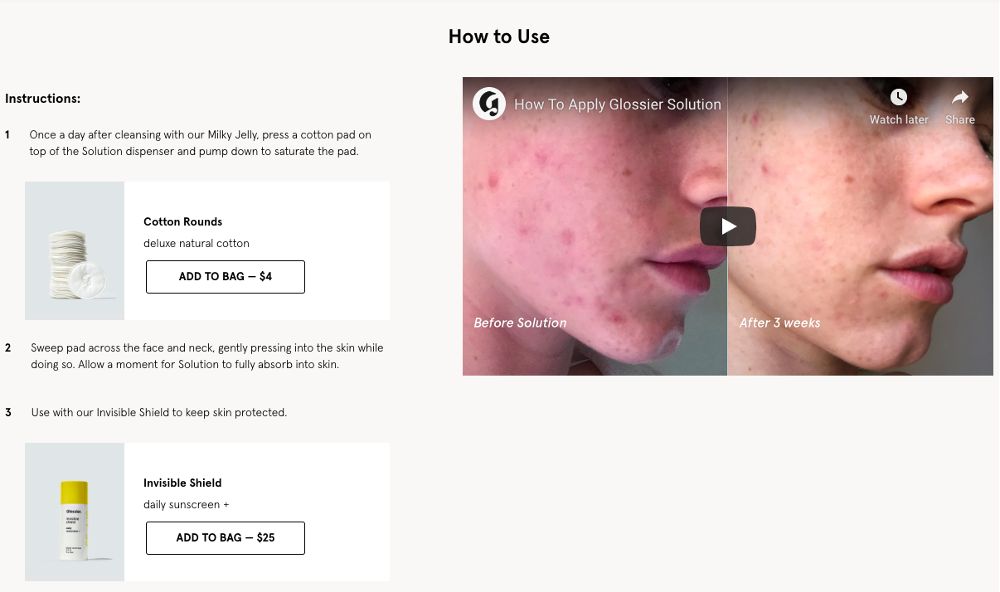
Glossier, a makeup brand, displays “How to Use” sections on its product pages. Along with the demonstration, they also suggest complementary products—in this case, cotton rounds and sunscreen. These products are subtle cross-sells but also offer value convenience to the customer.
Cross-selling is just one way to maximize sales conversions. Read more tips on ecommerce marketing strategies.
Cross-selling Techniques for Brick-and-Mortar Retailers
For brick-and-mortar retail stores, effective cross-selling is about creating strategies that will help you get the most out of your store’s foot traffic. Your aim is to maximize sales of your high-tier, low-priced older stock and new merchandise before you have to mark it down. At the same time, you also want to make your customers feel that you’re giving them more value for their money. This is important if you want to increase sales, widen your customer base, and build customer loyalty.
10. Showcase Items Prominently in the Store
Presentation plays a key role in creating more sales. Simply put, if customers are not able to see your merchandise, they won’t know that the items they are looking for are actually available for them to buy. In the same way, complementary items and common pairings should be displayed prominently in your store. This helps customers visualize how the pairings work together and motivates them to make the purchase.
Items that you frequently cross-sell should always be displayed together, or at least near each other. For example, you could display blazers and include a matching tie, or place your sock section beside your shoe section. Aside from minimizing the risk of losing customers while they try to search for products they need around your store, you will also impress your buyers with this smart and sensible customer service strategy.
Cross-sell Tip in Action

Trader Joe’s display is a perfect example of showcasing complementary products today. It puts taco ingredients in the same display to show customers how the products are perfect for an easy dinner. (Source: Pinterest)
Learn more about cross-merchandising strategies.
11. Continuously Train Sales Associates
A brick-and-mortar retail store’s biggest asset is its staff, and the staff’s role in boosting cross-selling product sales is key to a better bottom line. One of the best cross-selling tips for brick-and-mortar shops is to continuously train sales staff on products. They should have the ability to recall a broad selection of complementary items in the store. Additionally, they need to have the skills to analyze a customer’s needs and come up with a personalized suggestion for each one.
The goal is to provide personalized customer service while cross-selling products. This should be a crucial part of your sales staff’s training. Create role play exercises in which your sales team can practice scenarios with different types of customers. This activity should help strengthen their product knowledge and customer service skills, including the ability to customize and promote complementary products. Ensure your employees are able to justify their selection and make them explain their logic. They will also need to have a solid grasp of your store’s layout.
12. Ask Probing Questions
Another skill that your sales staff needs to know is how to ask probing questions. This is what will help them truly understand the customer’s needs and suggest the most appropriate product to cross-sell. While this might seem like a very simple thing to do, it’s important to note that customers can become sensitive and leave the store altogether if a sales person is either too aggressive or too passive.
Teach your reps to ask probing questions throughout the sales process. Their training should include knowing the right time and the right approach for asking probing questions. It should also teach them how to notice behavioral and verbal cues that can lead them to identify the right products and services for the customer.
13. Improve Transparency at the Checkout Counter
Customers are hesitant in purchasing products they didn’t intend to buy because they are not equipped with enough information to make last-minute decisions. Those who are more conscious of their budget might not find any interest in getting more products at the checkout counter. However, if you upgrade your point-of-sale (POS) system to include customer-facing displays, buyers can have a better view of their running total and any discounts.
Cross-sell Tip in Action

In addition to saving space, modern POS systems look and function better. Front-facing displays also put your customers at ease by letting them know real time what the register is ringing them for.
Vend is a retail POS system that’s fast and easy to use with any Mac or PC. It offers a customer-facing display, so buyers can quickly visualize the benefit of purchasing the products you’re cross-selling. Let customers into your world with Vend display.
14. Show Added Benefit of Complementary Products
Nowadays, customers who walk into your store have already taken time to do research online about the products they are coming in to buy. This can be an advantage to a well-trained salesperson because it becomes easier to help the customer visualize the benefits of a complementary product. We say visualize, because retail store owners shouldn’t rely on product specs and features that customers will rarely take time to read.
The human mind is more responsive to stories or images, so you need a more visual strategy when trying to cross-sell. Clothing stores use mannequins to display outfit suggestions, and grocery stores often showcase taste tests for food products. This gives customers an idea of the added value that your products can provide.

This boutique showcases its display with a complete outfit composed of the different items on the racks, displayed close together. (Source: Boutique Store Design)
15. Use Round Numbers When Appropriate
The psychology of pricing often emphasizes how customers are attracted to products with “just-below” price tag amounts (for example, $29.99); they often buy these instead of items with prices that are rounded (like $30.00). When it comes to cross-selling, show customers that they are getting more value for their money using rounded amounts. This increases the chance that they’ll buy the higher-priced alternative even when placed side-by-side with products sporting “just-below” price tags.
This is the advantage of being able to personalize your messaging. In your marketing emails, displays, and through your sales staff, you get to show added value to your customers beyond $19.99 price tags. Instead, you can tell customers things like, “For only $10 more, here are the additional benefits you’d get.”’ The easy comparison makes it more likely they’ll accept the added purchase.
Learn more retail marketing strategies you can implement for your business.
Tips for Effective Cross-selling
Maximizing the sales of products you plan to cross-sell requires knowing which merchandise will fit customers best. And when you only have a limited time for gaining the buyer’s attention before they complete their purchase, you need your suggestions to be on point. What can help is a reliable customization tool to ensure your online shop provides the best match to your customers every time.
Pipedrive is customer relationship management (CRM) software that provides you with a visual pipeline so you can nurture your customers to the point that they’re ready to accept cross-selling pitches. It’s easy to set up and customize and intuitive to use, which makes it perfect for businesses focused on moving sales opportunities through their sales pipeline.
Retargeting is a great technique for capturing follow-up sales from customers who have previously purchased from you. The trick to implementing this technique successfully is to track customer purchase history and segment your retargeting based on the audience and consumer behavior.
It’s not unusual to find cross-selling opportunities after the customer has already made and enjoyed a purchase. This is why after-sales service should be an important part of a retail store’s activities. Keep in mind that knowing when and how to suggest your product will determine how effective your strategy is to boost sales.
For retail stores, customers who call in requiring assistance are usually focused on resolving issues they’re having with their purchase, so it’s best to help them resolve their concerns before suggesting a new product. Salespeople who engage their customers with follow-up calls should make sure they are already prepared with products that best fit that particular customer. They can do this by using tools to analyze buying behavior before making their call.
For ecommerce stores, your opportunity to cross-sell doesn’t end once the customer completes a purchase. Post-purchase experience is a key moment in the customer journey that most ecommerce shops forget about. Don’t just send the receipt and the product—take advantage of the connection to develop loyalty and make special offers. Use post-purchase communications to offer further products, incentives, and value to the customer.
Giving away a reward or incentive can increase your cross-selling conversion rate. For ecommerce businesses, this usually comes in the form of free shipping or discounts for a certain volume or dollar value of purchase. For brick-and-mortar stores, you can go beyond discounts and use your creativity to offer unique incentives in exchange for additional purchase.
Here are some strategies you can try:
- Give a free gift instead of a discount.
- Start a loyalty program.
- Offer your products at a limited time.
Adding a fear-of-missing-out element to your cross-sell items will make customers feel more motivated to buy. For loyalty programs, make sure that it’s as personalized as possible. Create structured opportunities where perks are based on buying patterns. Train your sales team well on loyalty offerings so they can use them effectively in their cross-selling efforts.
Cross-selling vs Upselling: Understanding the Difference
Cross-selling and upselling are often mistaken for the same, but they are entirely different sales management strategies. Both are used to increase the overall value of a customer purchase. However, upselling is where you suggest additional products or services directly related to the one being purchased, while cross-selling involves offering additional products or services that complement the existing purchase. An upsell would include a multiyear warranty for a purchased product or even a newer model of that product, whereas a cross-sell would be a separate product that could simply be used with the purchased product.
Cross-selling Frequently Asked Questions (FAQs)
Cross-selling is incentivizing customers to buy additional products or services that complement the existing purchase. The right cross-selling strategy can significantly increase sales and build customer loyalty at the same time.
The effectiveness of your cross-selling efforts can be measured by the increase in the customer’s average sales volume (in dollars), sales breadth expansion (the number of products or services for each customer), and decrease in customer attrition. Your aggregate cross-selling ratio (the number of products or services divided by the number of clients) also improves.
Look into your store’s retail analytics to record your baseline rates before implementing a cross-selling technique so you can measure its effectiveness afterward.
Bundling, minimum spend rewards, related product recommendations, limited-time offers, social proof, and cross-merchandising are just a few cross-selling techniques you can implement in your retail store and online shop.
Bottom Line
Cross-selling is an important strategy for improving sales and growing your ecommerce or brick-and-mortar business. In fact, a study by McKinsey says it can boost profits by up to 30%. Experiment with our cross-sell tips to reap the benefits of recommending complementary products to your existing customers and keep your business thriving.

